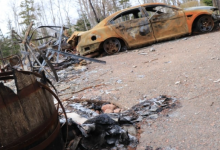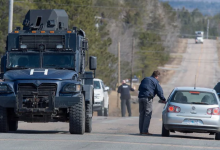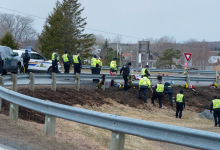Complexity of N.S. shooting investigation ‘without precedent,’ in Canada, expert says
Experts say one of the deadliest mass killings in modern Canadian history may become one of the most complex police investigations the country has ever seen.
A little more than a week ago, a gunman went on a 13-hour rampage in rural Nova Scotia that covered 100 kilometres and killed 22 people. He burned down homes, wore an RCMP uniform and drove a mock-up police car during the ordeal.
In total, the RCMP are sifting through 16 crime scenes, a colossal undertaking.
“It is without precedent,” in Canada, said Michael Arntfield, a criminologist at Western University in London, Ont.
“I mean, pick your variable, the scale of this tragedy and the number of victims. The distance covered, the duration of time, the impersonation of a police officer.”
With the shooter dead, there will be no criminal case.
But police are still trying to piece together how he killed his victims and why.
This is important work, even without a pending trial, says Dr. John Butt, a retired forensic pathologist.
“You could have people say, ‘Well, it’s not going to court because the assailant is dead.’ But I would say that it’s still a matter of importance, and that includes the issue of closing the case definitively so that there are no second guesses,” said Butt.
Butt was Nova Scotia’s medical examiner during Swissair disaster in 1998, when 229 people died when their plane slammed into the waters off Peggys Cove.
“What is so important to families is to know, as much as possible, that there was no suffering. That sounds trite, but that is important to the families,” he said. “That’s a huge issue for the families, without question, is how quickly the death occurred.”
The RCMP also want to figure out how the shooter managed to make his vehicle look so similar to an authentic police cruiser and how he managed to get a real RCMP uniform. Both helped him evade detection.

The investigation is hampered by the large area the gunman travelled and destruction he left in his wake, including burnt-out homes.
“Fire scenes take an extensive amount of time to sort through,” said Kevin Bryan, a retired York Regional Police detective.
Even once the evidence is identified, investigators can find themselves in a race to preserve those clues against the power of Mother Nature. Should the weather turn bad, valuable clues could be lost.
“They’re outdoor scenes with ephemeral and perishable evidence,” said Arntfield.
When all the evidence is collected, it could take days or weeks before that material is examined, which means people could be waiting for answers, he said.
“Regardless of how the investigation pans out, the enduring question will be motive and can we get answers on that?” said Arntfield.
CBC








Redes Sociais - Comentários